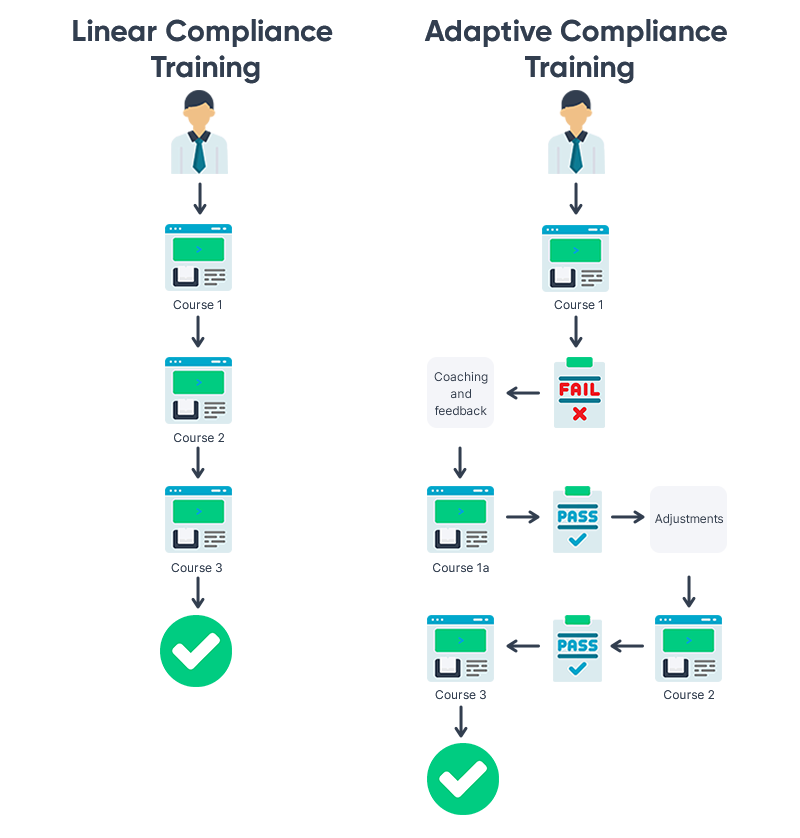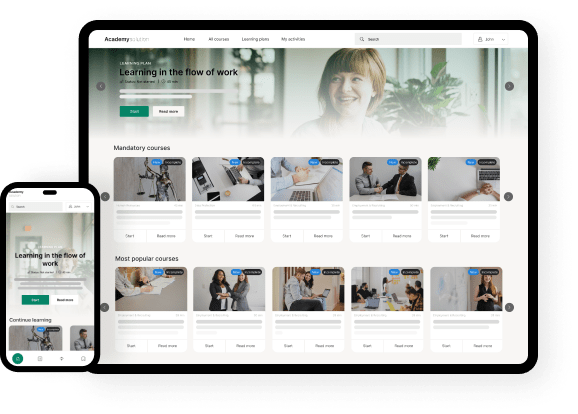Majority of companies believe that digital learning is now the “new normal” in corporate training. The same goes for relevant employee training programs such as regulatory compliance. While the adoption of e-learning has skyrocketed recently, many companies still struggle to maintain consistency and success. Some of the general issues attributed to online compliance training are:

Conducting compliance training online might appear a tough row to hoe. But with the right approach and tools, your online compliance training program can be worth its weight in gold. In this light, we’re giving away four practical tips to help you succeed in your online compliance training process.
Tip 1: Tailor online compliance training courses to your employees’ specific needs
It’s reported that 71 % of organizations do not assess staff compliance proficiencies and skills regularly. As a result, companies don’t have appropriate and valid metrics on which to base their compliance training program.
When doing compliance training online, knowing your audience and understanding their specific needs will allow you to tailor your courses and content delivery. Remember that your employees have divergent compliance competencies and may face unique challenges at work.
To avoid irrelevance and incompatibility in compliance training courses, always tie them to circumstances and scenarios that employees would likely encounter in their job position. Compliance requirements may be entirely different for executives than the administrative staff. So, having role-based and story-led training modules or tools will be more relatable and effective for everyone.
Tip 2: Allow access through multiple devices
You might be thinking mostly about content creation. However, you also need to think about course execution.
Content delivery can be a significant issue in an online learning setting, especially in matters relating to accessibility. For example, the HR staff may require complex risk and management interviewing simulations via Zoom or Microsoft Teams. And in a situation like this, training administrators can’t afford to confuse or lose their employees during the process.
To successfully administer online compliance training, let your employees access their courses on multiple devices like smartphones, tablets, and desktops. This approach promotes greater flexibility and improved learning engagement on the part of the training participants.
Tip 3: Distinguish adaptive and linear compliance training
Online compliance training can take two forms: adaptive and linear.
Linear compliance training is a typical online training approach used by most organizations. It’s a straightforward and one-size-fits-all approach that simply leads learners from point A to point B. The employee takes a course, moves from one slide to another, and then accomplishes item by item.
As you can see, a linear approach demands learners to absorb information by running through different training stages. Frequently, this process requires memorization of short and simple compliance concepts.
On the other hand, adaptive compliance training allows employees to have more interaction with the content. It mimics physical activity and enables a personalized experience through learning by doing. Training experiences are uniquely made so that employees can build critical decision-making skills.
Both approaches apply effectively in various circumstances. For example, linear online training works best if you’re dealing with ideas that are easy to grasp and internalize. Adaptive training can be your go-to process when you want your employees to engage in e-learning activities that help them achieve long-term retention.
To decide which among the two online learning approaches is best for your organization depends on your overall objectives. Nonetheless, knowing the difference between a linear and adaptive approach will help you set the tone for your online compliance training program.

Tip 4: Stretch trainees’ imagination with good storytelling
You might not be aware of it, but good storytelling in compliance training makes for an improved learning experience. That’s because real-life stories resonate with your employees’ lives. Good storytelling also inspires and motivates.
When you think about doing compliance training online, your ultimate goal is not just to teach desired behaviors. It’s also to get your employees to apply these appropriate behaviors in an actual company setup. And that’s when using storytelling in online compliance training can be very beneficial.
Incorporating storytelling in e-learning is possible through the following examples:
- Video presentations that show simulations and scenarios
- News stories – connecting to a report of breach or an aspect of compliance with real-world consequences
- Gamified challenges that highlight a compliance story about the effects of violating regulations.
Bonus tip: Get the best compliance training platform
Companies need to build awareness among their staff about the significance of compliance in business. But it isn’t possible if employees continue to think that compliance training is nothing but a dull and exhausting endeavor. While online compliance training may provide a solution to this dilemma, there’s still a lot of work to be done.
Applying all the tips mentioned will surely give you a competitive edge in your online compliance training program. But to take a step further, you need to have the best learning platform to help you get the best results.
Good thing for you, our platform allows us to create for you the perfect compliance training solution that can be tailored to your specific e-learning requirements.
Use this link to learn more about online compliance training opportunities.


